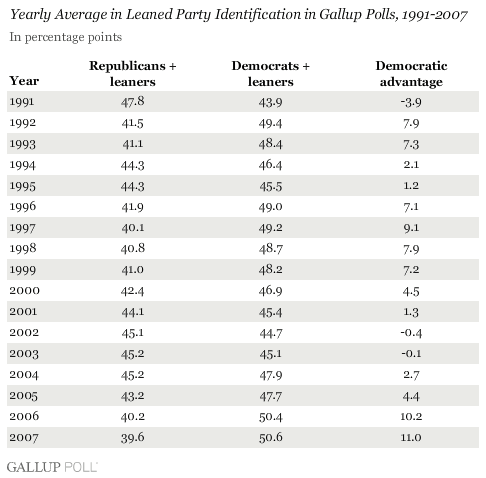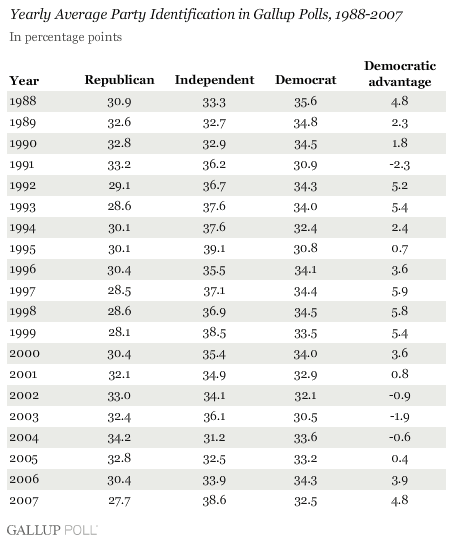PRINCETON, NJ -- The percentage of Americans who identified as Republicans in 2007 is the lowest of any of the 20 calendar years since 1988 that ���۴�ýhas conducted its interviewing primarily by telephone. An average of 27.7% of Americans identified as Republicans, based on more than 26,000 ���۴�ýinterviews in 2007. The previous low in Republican identification was 28.1% in 1999.
Meanwhile, 32.5% of Americans identified as Democrats and 38.6% as political independents last year. The latter percentage is on the high end of what ���۴�ýhas measured in the last two decades, surpassed by only the 39.1% independent identification average from 1995. The high point for Democratic identification came in 1988, when 35.6% said they were Democrats.
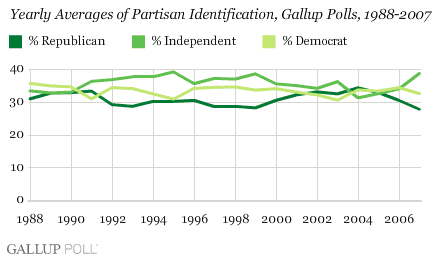
Republican identification has dropped by roughly two percentage points in each of the last three years, and is now nearly seven points below the 20-year high of 34.2% in 2004. Democratic identification also dropped by about two percentage points in 2007 -- from 34.3% in 2006 -- while the proportion of independents rose significantly, from 33.9% in 2006 to 38.6% last year.
The current inflation in the number of political independents is consistent with a cyclical pattern to party identification that corresponds with the political calendar. As noted last August (see "���۴�ýFinds Increase in Independents, Typical of Off-Years" in Related Items), ���۴�ýtypically observes a rise in the percentage of independents during the year between national elections. Conversely, ���۴�ýhas seen a dip in independents in the third quarter of years right before national elections (such as in 1992, 1996, 1998, 2000, 2004, and 2006). At that stage, people are presumably more tuned in to political matters, the major parties are holding their conventions, and voters are staking out their sides in the election.
The net effect of the recent changes is that Democrats now have a nearly five-point advantage in party identification, up from roughly four points in 2006, when the Democrats prevailed in the midterm elections. In 2004 and 2005, roughly equal proportions of Americans identified as Republicans and Democrats.
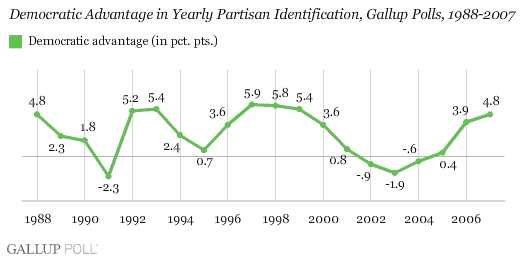
The Democratic advantage is even greater when taking into account the partisan leanings of independents. In addition to the 32.5% of Americans who initially identified as Democrats in 2007, another 18.1% initially said they were independents but expressed a Democratic leaning, for a total of 50.6% Democrats and Democratic leaners. A total of 39.6% of Americans identified with, or leaned to, the Republican Party.
That 11-point gap in partisan leaning is the largest ���۴�ýhas observed since it began regularly measuring partisan leanings in 1991, topping the previous high gap of 10.2 points from last year.
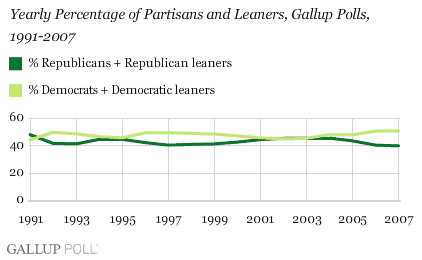
Implications
The Democrats not only maintained but increased their partisanship advantage over the Republicans in 2007, at a time when the ranks of independents were also swelling in the mid-phase of the two-year party ID cycle. As a result, the Democrats are heading into the presidential election year in a position of strength relative to the Republican Party.
History suggests that the percentage of Americans identifying as independents will dip later this year, most likely over the summer. The question is by how much, and whether either party will grow proportionally larger as a result.
Survey Methods
These results are based on combined data from 26,282 telephone interviews with randomly selected national samples of approximately 1,000 adults, aged 18 and older, conducted in 2007. The yearly average is computed by averaging the four quarterly averages from 2007.
For results based on this sample, one can say with 95% confidence that the maximum error attributable to sampling and other random effects is ±1 percentage point. In addition to sampling error, question wording and practical difficulties in conducting surveys can introduce error or bias into the findings of public opinion polls.
